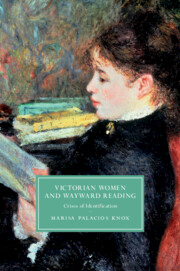Book contents
- Victorian Women and Wayward Reading
- Cambridge Studies in Nineteenth-Century Literature and Culture
- Victorian Women and Wayward Reading
- Copyright page
- Dedication
- Contents
- Figures
- Acknowledgments
- Introduction
- Chapter 1 Masculine Identification and Marital Dissolution
- Chapter 2 Novels without Heroines: Sensation and Elective Identification
- Chapter 3 Character Invasion and the Victorian Actress
- Chapter 4 Antipathetic Telepathy: Female Mediums and Reading the Enemy
- Chapter 5 “The Valley of the Shadow of Books”: The Morbidity of Female Detachment
- Chapter 6 The New Crisis: Can We Teach Identification?
- Notes
- Works Cited
- Index
- Cambridge Studies in Nineteenth-Century Literature and Culture
Introduction
Published online by Cambridge University Press: 30 October 2020
- Victorian Women and Wayward Reading
- Cambridge Studies in Nineteenth-Century Literature and Culture
- Victorian Women and Wayward Reading
- Copyright page
- Dedication
- Contents
- Figures
- Acknowledgments
- Introduction
- Chapter 1 Masculine Identification and Marital Dissolution
- Chapter 2 Novels without Heroines: Sensation and Elective Identification
- Chapter 3 Character Invasion and the Victorian Actress
- Chapter 4 Antipathetic Telepathy: Female Mediums and Reading the Enemy
- Chapter 5 “The Valley of the Shadow of Books”: The Morbidity of Female Detachment
- Chapter 6 The New Crisis: Can We Teach Identification?
- Notes
- Works Cited
- Index
- Cambridge Studies in Nineteenth-Century Literature and Culture
Summary
The introduction to Victorian Women and Wayward Reading traces the vexed literary and philosophical history of identification as a feminized reading response and uncovers a concurrent history of wayward reading in the Victorian era. The eponymous heroine of Charlotte Lennox’s The Female Quixote (1752) embodied identification as a feminine mode of delusional and egoistic reading, in contrast to the philosophically valorized response of sympathy. Through her fictional heroine, Lennox created a convenient archetype for female susceptibility that would recur over the next 150 years in criticism, cartoons, and novels, from Northanger Abbey to Madame Bovary and beyond. The introduction explicates how various modern conceptions and critiques of literary identification possess nineteenth-century forebears in explicit disapproval and tacit endorsement of stereotypically feminine reading practices. While Victorian critics and modern scholars alike have concentrated on sympathy and empathy as redemptive readerly affects, the introduction shifts focus to Victorian women’s intentional identification, beyond the stereotypically feminine arenas of emotion and interpersonal relationships. This introduction refines and clarifies an active definition of literary identification based in cognitive psychology, to demonstrate how identification can be intentionally directed by the reader and illuminate possibilities for wayward reading in the past and present.
Keywords
- Type
- Chapter
- Information
- Victorian Women and Wayward ReadingCrises of Identification, pp. 1 - 22Publisher: Cambridge University PressPrint publication year: 2020

